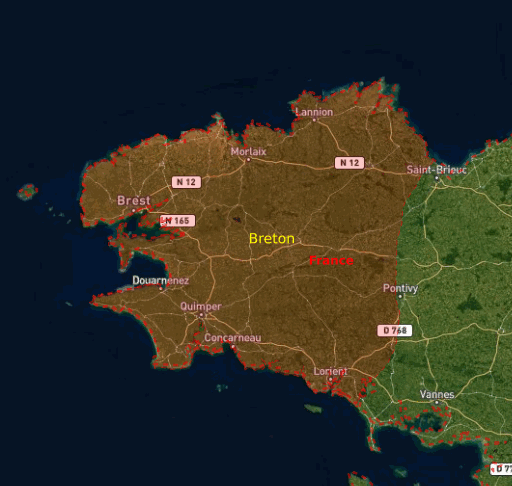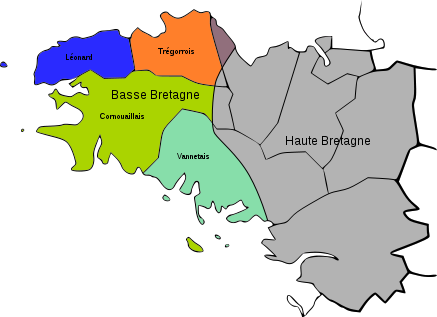Breton
Conjugate VerbsFacts
- Language: Breton
- Alternate names: BREZHONEG
- Language code: bre
- Language family: Indo-European, Classical Indo-European, Celtic, Nuclear Celtic, TGB Celtic, Insular Celtic, Brythonic, Southwestern Brythonic
- Number of speakers: 500000
- Vulnerability: risk [Read more...]
- Script:
More information:
Introduction
Breton is a Southwestern Brittonic language of the Celtic language family spoken in Brittany, modern-day France.
Breton is spoken mainly in Lower Brittany, but also in a more dispersed way in Upper Brittany (where it is spoken alongside Gallo and French), and in areas around the world that have Breton emigrants.

Breton language speaking area
The Breton Dialects
The four traditional dialects of Breton correspond to medieval bishoprics rather than to linguistic divisions. They are leoneg (léonard, of the county of Léon), tregerieg (trégorrois, of Trégor), kerneveg (cornouaillais, of Cornouaille), and gwenedeg (vannetais, of Vannes). In addition to these, Goelo dialect is spoken in the extreme north-east.
| _ | Leoneg |
| _ | Tregerieg |
| _ | Kerneveg |
| _ | Gwenedeg |
| _ | Goelo |
The Breton Verb
The Breton verb conjugates for- aspect: perfective, imperfective (progressive, habitual). The perfective expresses a completed action and the imperfective an habitual or ongoing action.
- mood: indicative, imperative, subjunctive (rare).
- voice: active and passive.
- tense: present, future, imperfect, preterite (restricted to the written language), conditional present (or potential) and conditional past (or hypothetical).
- person and number: 1s, 2s, 3s; 1p, 2p, 3p. There is also an impersonal or general form.
Non-finite forms
The verbal noun: may be identical with the root, but sometimes it carries a suffix (-añ is the commonest; others are -iñ, -et, -at, etc).
The present participle and gerund are formed with the verbal noun plus a preceding particle (o for present participle, ur for gerunds).
The past participle is formed by adding -et to the verbal root.
Irregular Verbs
Most Breton verbs are regular. The are some common verbs, however, that are irregular:- mont (‘to go’),
- ober (‘to do’),
- dont (‘to come’),
- bezañ (‘to be’),
- kaout (‘to have’). Kaout combines a person marker with the tensed form, therefore it shows different forms for 3rd person singular masculine and femenine.
Verblist
azezañ, barn, beajiñ, berañ, bevañ, bezañ, carein, chadennañ, choaz, chom, c'hoari, dañsal, debriñ, deskein, deskiñ, deviñ, dibab, dichadennañ, digeriñ, dilenn, dilestrañ, dilivañ, dilouzañ, disaotrañ, disheñvelaat, diuz, diwiskañ, doganiñ, donet, dont, doujañ, dua, enklask, evañ, fallaat, fellout, fiñval, freuzañ, gallout, genel, glanaat, gouzout, gwalc'hiñ, gwelet, gwelet a ran da gazh er jardin, gwelout, gwerzhañ, gwilc'hañ, gwildronañ, gwriat, hadañ, hasta, heñvelaat, kana, kanañ, kaout, kaozeal, kargañ, karout, kas, kavout, kelenn, kemmañ, kinnig, klask, klevout, komz, konikleta, korolliñ, koshaat, kousket, krediñ, kregiñ, krouiñ, lakaat, laza, lenn, lestrañ, livañ, lousaat, louzañ, maga, maha, mala, melenaat, merglañ, mervel, mond, mont, moulañ, neuñviñ, nijal, ober, ouzhpennañ, pellgomz, pennekaat, perc'hennañ, pika, pouezañ, prenañ, rakgwelet, rakwelet, reiñ, roeñvat, rosta, saotrañ, selled, sellet, sellout, sevel, sina, sistra, skrivañ, soñjal, spia, studiañ, taga, teurel, touellañ, treiñ.
Verblists
References
- Press, Ian. A Grammar of Modern Breton. Mouton Grammar Library. Mouton de Gruyter. Amsterdam.
- Hemon, Roparz. A Historical Morphology and Syntax od Breton. Mediaeval and modern Breton Series. The Dublin Institute for Advanced Studies.